Reduction of Electricity Prices Using the Train to Grid (T2G) System in Urban Railway
Abstract
:1. Introduction
- (1)
- The EV needs to overcome the limitation of battery capacity and charging time.
- (2)
- To utilize the V2G system, the investments should be made in the infrastructure used for battery charging and discharging.
- (3)
- All drivers must obtain an approval for using the EV they own.
2. T2G System
2.1. Wireless Railway Vehicles
2.2. T2G System
2.3. Calculation of the ESS Capacity of a Wireless Train for High-Speed Charging
- -
- Voltage of the 32 modules connected in series:
- -
- Supercapacitor capacitance of the 32 modules:
- -
- Maximum supercapacitor energy quantity of the 32 modules:
- -
- Maximum available supercapacitor energy quantity of the 32 modules:
3. Composition of Electricity Prices for Korean Urban Railroads
- -
- The method to reduce both demand and energy charges will be proposed.
- -
- In simulations, the prices corresponding to the demand charge in Table 3 are substituted into in (6), which is the new calculation equation of the electricity prices based on the T2G system.
- -
- Because the simulations are performed using the summer data, the prices corresponding to the summer in the energy charge of Table 3 ar substituted into in (6).
- -
- The simulations are performed on 24 h basis. The classifications of the off-peak, mid-peak, and on-peak time among 24 h are presented in Table 4.
4. Reduction Method of Electricity Prices Using T2G
5. Simulation Results
5.1. Number of Korean Urban Railway Vehicles Scheduled for Operation at Each Scheduled Time
5.2. Variations of Electric Energy Consumption in Each Korean Urban Railroad Line by the Proposed Method
5.3. Reduction of Electricity Prices by the Proposed Method
- -
- ConditionsLine: No. 2, Time: 9
- -
- Conventional MethodEnergy consumption: 63,789 kWhDemand charge: 7.8 $/kWh × 63,789 kWh = $497,554
- -
- Proposed methodNumber of railway vehicles available for use for reverse power transmission: 31Energy Consumption: 63,789 kWh − 31 × 60.31 kWh = 61,919 kWhDemand charge: 7.8 $/kWh × 61,919 kWh = $482,968
6. Conclusions
Acknowledgments
Author Contributions
Conflicts of Interest
Nomenclature
| Basic charge | |
| Highest peak power in 12 months | |
| Number of months | |
| Electric rate per hour based on the TOU price | |
| Power consumption per hour | |
| Number of railway being used for reverse power transmission | |
| Number of railway being charged | |
| Number of railway being charged at t time | |
| Total number of railway | |
| Number of railway operating at t time | |
| Number of railway operating at next time | |
| Number of railway being used for reverse power transmission at t time | |
| Time-of-use at t time | |
| Time-of-use at next time | |
| Usable ESS capacity of wireless railway vehicles |
References
- Rahman, I.; Vasant, P.M.; Singh, B.S.M.; Abdullah-Al-Wadud, M.; Adan, N. Review of recent trends in optimization techniques for plug-in hybrid, and electric vehicle charging infrastructures. Renew. Sustain. Energy Rev. 2016, 58, 1039–1047. [Google Scholar] [CrossRef]
- Gan, L.; Topcu, U.; Low, S.H. Optimal decentralized protocol for electric vehicle charging. IEEE Trans. Power Syst. 2013, 28, 940–951. [Google Scholar] [CrossRef]
- Liu, Z.; Wen, F.; Ledwich, G. Optimal planning of electric-vehicle charging stations in distribution systems. IEEE Trans. Power Deliv. 2013, 28, 102–110. [Google Scholar] [CrossRef]
- Leou, R.-C.; Su, C.-L.; Lu, C.-N. Stochastic analyses of electric vehicle charging impacts on distribution network. IEEE Trans. Power Syst. 2014, 29, 1055–1063. [Google Scholar] [CrossRef]
- Mohamed, A.; Salehi, V.; Ma, T. Real-time energy management algorithm for plug-in hybrid electric vehicle charging parks involving sustainable energy. IEEE Trans. Sustain. Energy 2014, 5, 577–586. [Google Scholar] [CrossRef]
- Veldman, E.; Verzijlbergh, R.A. Distribution grid impacts of smart electric vehicle charging from different perspectives. IEEE Trans. Smart Grid 2014, 6, 333–342. [Google Scholar] [CrossRef]
- De Hoog, J.; Alpcan, T.; Brazil, M.; Thomas, D.A.; Mareels, I. A market mechanism for Electric Vehicle charging under network constraints. IEEE Trans. Smart Grid 2016, 7, 827–836. [Google Scholar] [CrossRef]
- Li, R.; Wu, Q.; Oren, S.S. Distribution locational marginal pricing for optimal electric vehicle charging management. IEEE Trans. Power Syst. 2014, 29, 203–211. [Google Scholar] [CrossRef]
- Kim, J.-H.; Kim, C.-H. Smart EVs Charging Scheme for Load Leveling Considering ToU Price and Actual Data. J. Electr. Eng. Technol. 2017, 12, 1–10. [Google Scholar] [CrossRef]
- Go, H.-S.; Ryu, J.-H.; Kim, J.; Kim, G.-D.; Kim, C.-H. New Prediction of the Number of Charging Electric Vehicles Using Transformation Matrix and Monte-Carlo Method. J. Electr. Eng. Technol. 2017, 12, 451–458. [Google Scholar] [CrossRef]
- Amini, M.H.; Kargarian, A.; Karabasoglu, O. ARIMA-based decoupled time series forecasting of electric vehicle charging demand for stochastic power system operation. Electr. Power Syst. Res. 2016, 140, 378–390. [Google Scholar] [CrossRef]
- Melhorn, A.C.; McKenna, K.; Keane, A.; Flynn, D.; Dimitrovski, A. Autonomous plug and play electric vehicle charging scenarios including reactive power provision: A probabilistic load flow analysis. IET Gener. Transm. Distrib. 2017, 11, 768–775. [Google Scholar] [CrossRef]
- Vachirasricirikul, S.; Ngamroo, I. Robust LFC in a smart grid with wind power penetration by coordinated V2G control and frequency controller. IEEE Trans. Smart Grid 2014, 5, 371–380. [Google Scholar] [CrossRef]
- Kavousi-Fard, A.; Niknam, T.; Fotuhi-Firuzabad, M. Stochastic reconfiguration and optimal coordination of V2G plug-in electric vehicles considering correlated wind power generation. IEEE Trans. Sustain. Energy 2015, 6, 822–830. [Google Scholar] [CrossRef]
- Alam, M.J.E.; Muttaqi, K.M.; Sutanto, D. Effective utilization of available PEV battery capacity for mitigation of solar PV impact and grid support with integrated V2G functionality. IEEE Trans. Smart Grid 2016, 7, 1562–1571. [Google Scholar] [CrossRef]
- Kumar, K.N.; Sivaneasan, B.; Cheah, P.H.; So, P.L.; Wang, D.Z.W. V2G capacity estimation using dynamic EV scheduling. IEEE Trans. Smart Grid 2014, 5, 1051–1060. [Google Scholar] [CrossRef]
- Christian Chukwu, U.C.; Mahajan, S.M. Real-time management of power systems with V2G facility for smart-grid applications. IEEE Trans. Sustain. Energy 2014, 5, 558–566. [Google Scholar] [CrossRef]
- Mendes, P.R.C.; Valver deIsorna, L.; Bordons, C.; Normey-Rico, J.E. Energy management of an experimental microgrid coupled to a V2G system. J. Power Sources 2016, 327, 702–713. [Google Scholar] [CrossRef]
- Tang, Y.; Zhong, J.; Bollen, M. Aggregated optimal charging and vehicle-to-grid control for electric vehicles under large electric vehicle population. IET Gener. Trans. Distrib. 2016, 10, 2012–2018. [Google Scholar] [CrossRef]
- Karfopoulos, E.L.; Hatziargyriou, N.D. Distributed coordination of electric vehicles providing V2G services. IEEE Trans. Power Syst. 2016, 31, 329–338. [Google Scholar] [CrossRef]
- Tan, K.M.; Ramachandaramurthy, V.K.; Yong, J.Y. Integration of electric vehicles in smart grid: A review on vehicle to grid technologies and optimization techniques. Renew. Sustain. Energy Rev. 2016, 53, 720–732. [Google Scholar] [CrossRef]
- Go, H.S.; Kim, D.-U.; Kim, J.-H.; Lee, S.-J.; Kim, S.-K.; Kim, E.-S.; Kim, C.-H. A Study on Voltage Sag Considering Real-Time Traffic Volume of Electric Vehicles in South Korea. J. Electr. Eng. Technol. 2015, 10, 1492–1501. [Google Scholar] [CrossRef]
- Peng, C.; Zou, J.; Lian, L.; Li, L. An optimal dispatching strategy for V2G aggregator participating in supplementary frequency regulation considering EV driving demand and aggregator’s benefits. Appl. Energy 2017, 190, 591–599. [Google Scholar] [CrossRef]
- Lam, A.Y.S.; Leung, K.-C.; Li, V. Capacity estimation for vehicle-to-grid frequency regulation services with smart charging mechanism. IEEE Trans. Smart Grid 2016, 7, 156–166. [Google Scholar] [CrossRef]
- Manbachi, M.; Farhangi, H.; Palizban, A.; Arzanpour, S. A novel Volt-VAR Optimization engine for smart distribution networks utilizing Vehicle to Grid dispatch. Int. J. Electr. Power Energy Syst. 2016, 74, 238–251. [Google Scholar] [CrossRef]
- Go, H.-S.; Cho, I.-H.; Ryu, J.-H.; Kim, G.-D. Study of Electric Charge Saving Plan Using High-speed Charging Wireless Railway System. J. Korean Soc. Railw. 2017, 20, 31–42. [Google Scholar] [CrossRef]
- Kim, G.-D.; Lee, J.-M.; Han, Y.-J.; Ryu, J.-H. Development of Wireless Train Power Supply Technology Using 1MW—Class High Speed Electric Power Charge Storage; Korea Railroad Research Institute: Uiwang, Korea, 2015. [Google Scholar]
- Steiner, M.; Klohr, M.; Pagiela, S. Energy storage system with ultracaps on board of railway vehicles. In Proceedings of the European Conference on Power Electronics and Applications, Aalborg, Denmark, 2–5 September 2007. [Google Scholar]
- Richardson, M.B. Flywheel energy storage system for traction application. In Proceedings of the International Conference on Power Electronics, Machines, and Drives, Sante Fe, NM, USA, 4–7 June 2002. [Google Scholar]
- Kampeerawat, W.; Koseki, T. A strategy for utilization of regenerative energy in urban railway system by application of smart train scheduling and wayside energy storage system. Energy Procedia 2017, 138, 795–800. [Google Scholar] [CrossRef]
- Roch-DupréÁlvaro, D.; López-López, J.; Pecharromán, R.R.; Cucala, A.P.; Fernández-Cardador, A. Analysis of the demand charge in DC railway systems and reduction of its economic impact with Energy Storage Systems. Int. J. Electr. Power Energy Syst. 2017, 93, 459–467. [Google Scholar] [CrossRef]
- Ratniyomchai, T.; Hillmansen, S.; Tricoli, P. Recent developments and applications of energy storage devices in electrified railways. IET Electr. Syst. Transp. 2014, 4, 9–20. [Google Scholar] [CrossRef]
- Kim, H.; Heo, J.-H.; Park, J.-Y.; Yoon, Y.T. Impact of Battery Energy Storage System Operation Strategy on Power System: An Urban Railway Load Case under a Time-of-Use Tariff. Energies 2017, 10, 68. [Google Scholar] [CrossRef]
- Ghaviha, N.; Campillo, J.; Bohlin, M.; Dahlquist, E. Review of Application of Energy Storage Devices in Railway Transportation. Energy Procedia 2017, 105, 4561–4568. [Google Scholar] [CrossRef]
- Using Trains to Send Power to the Grid. Available online: https://www.asme.org/engineering-topics/articles/energy/using-trains-send-power-grid (accessed on 19 February 2018).
- Available online: https://www.aresnorthamerica.com/article/8957-railway-solution-for-grid-scale-energy-storage (accessed on 19 February 2018).
- Available online: http://www.seoulmetro.co.kr (accessed on 19 February 2018).
- Available online: http://www.kepco.co.kr (accessed on 19 February 2018).
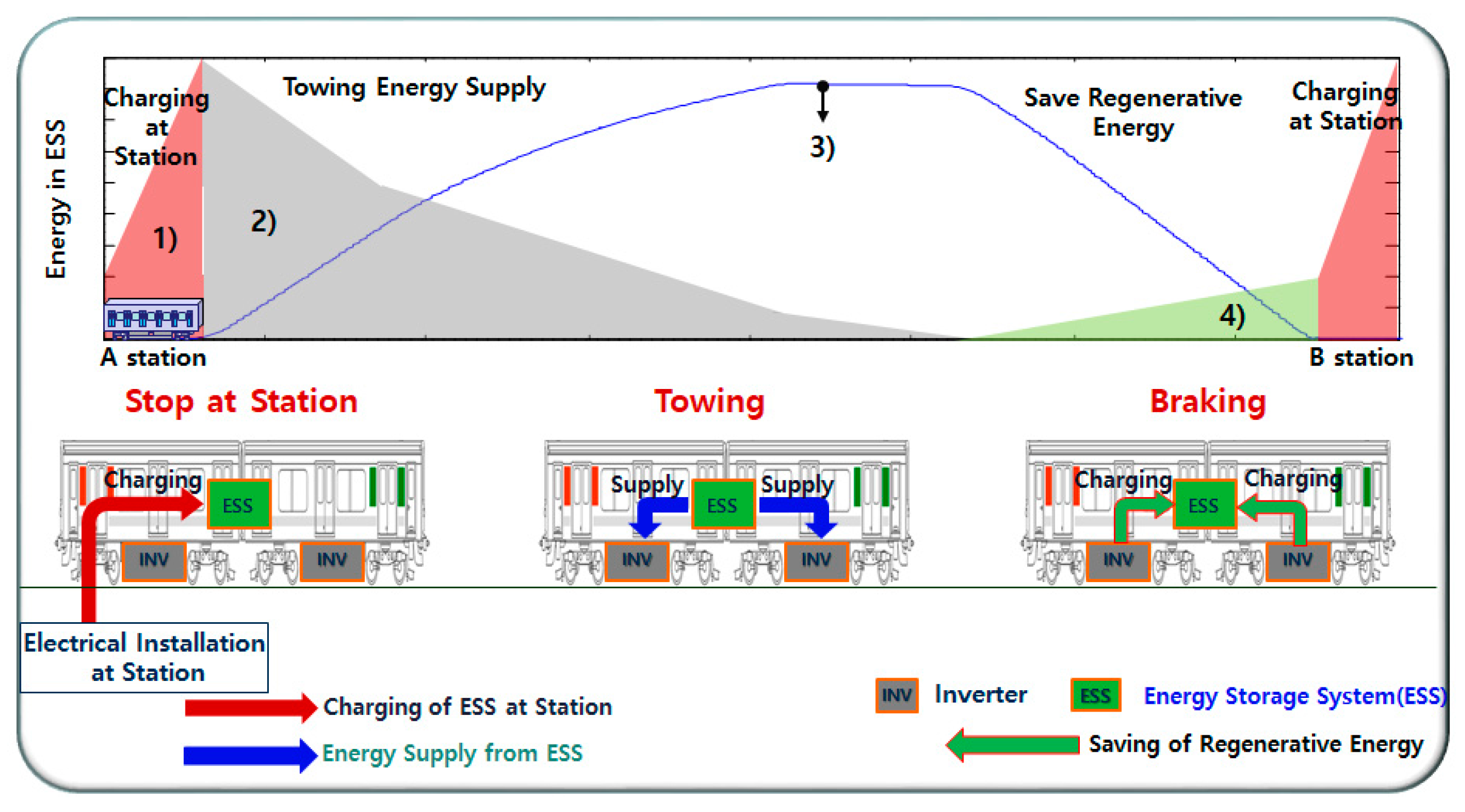

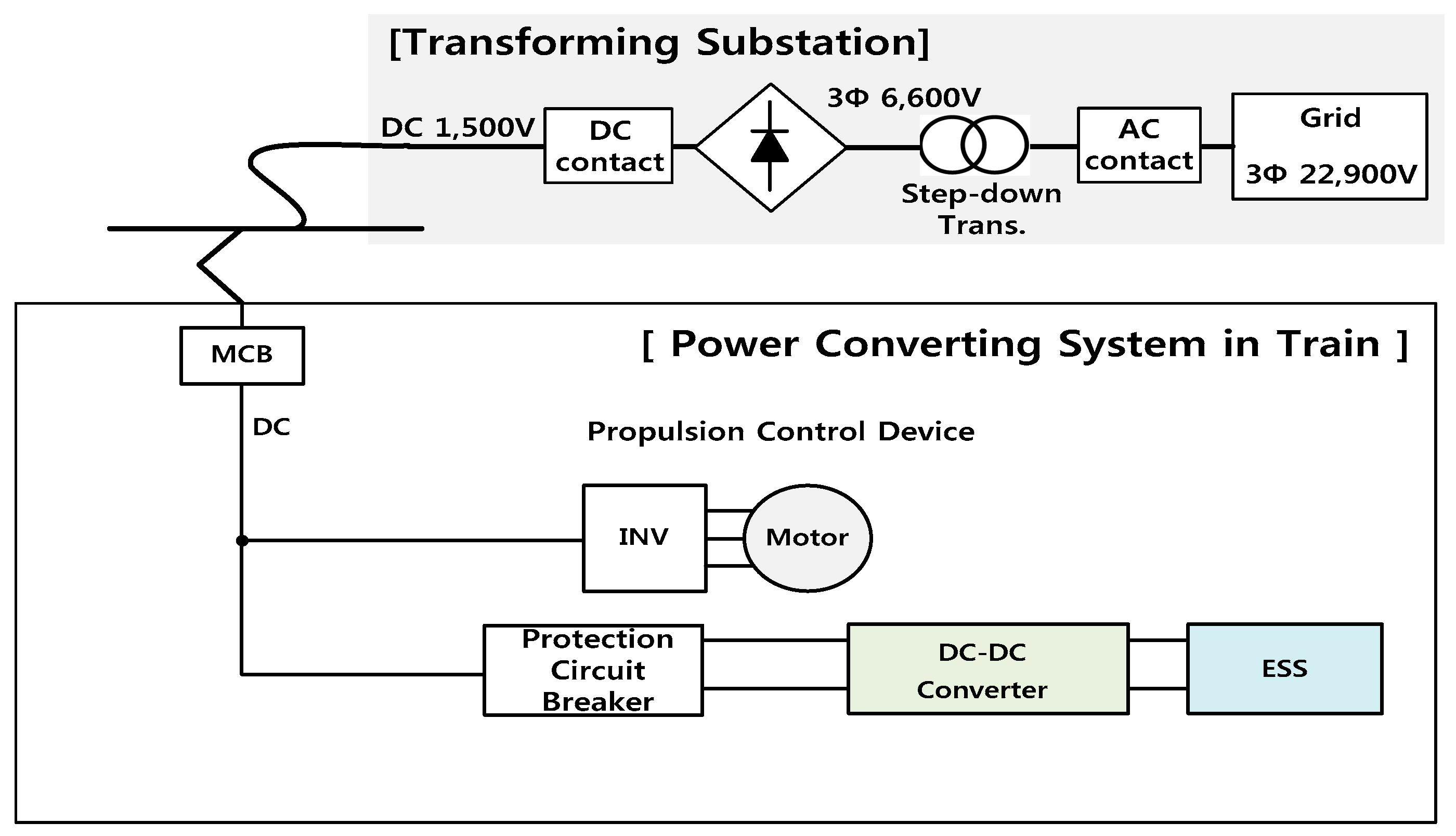
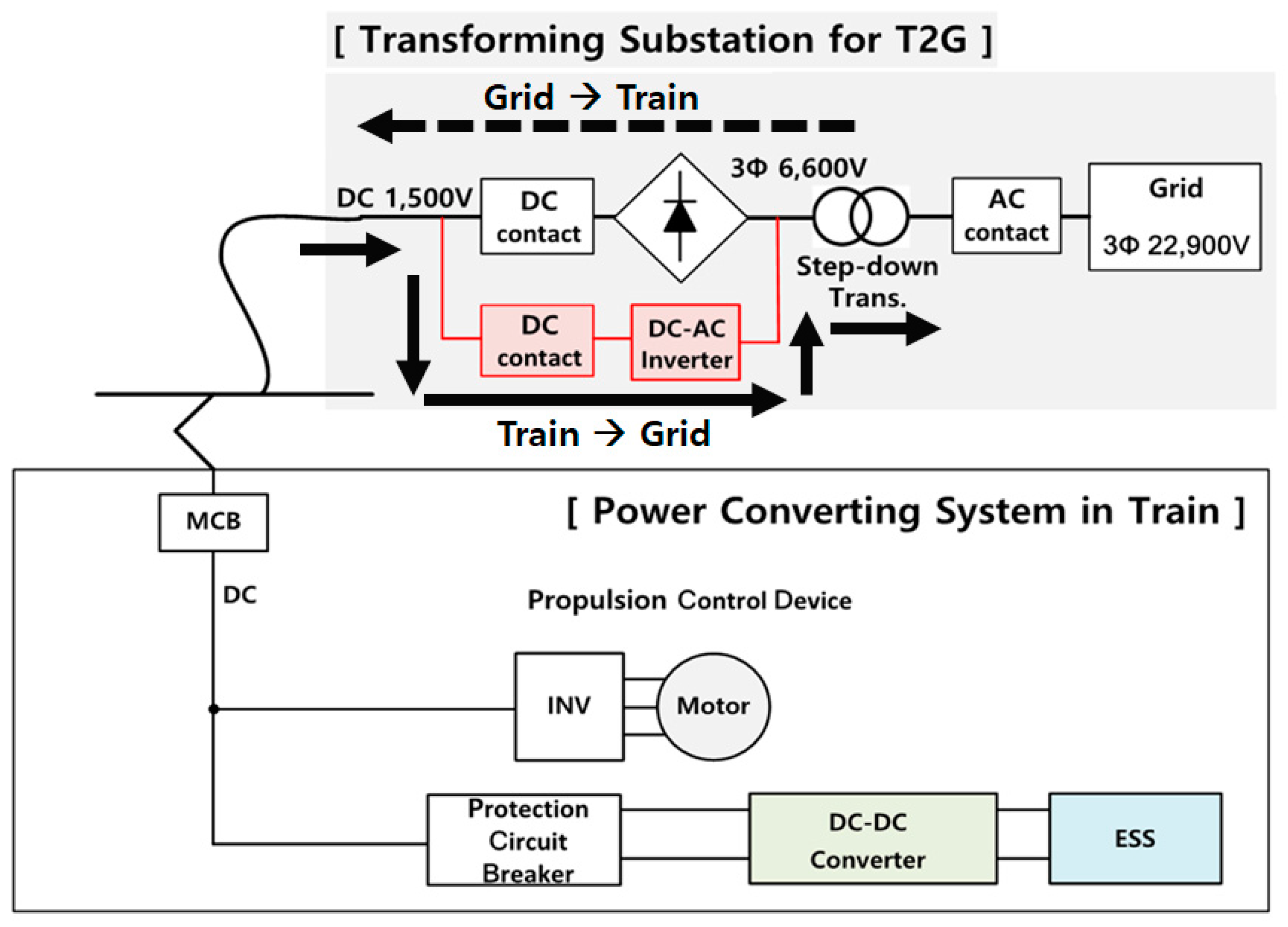

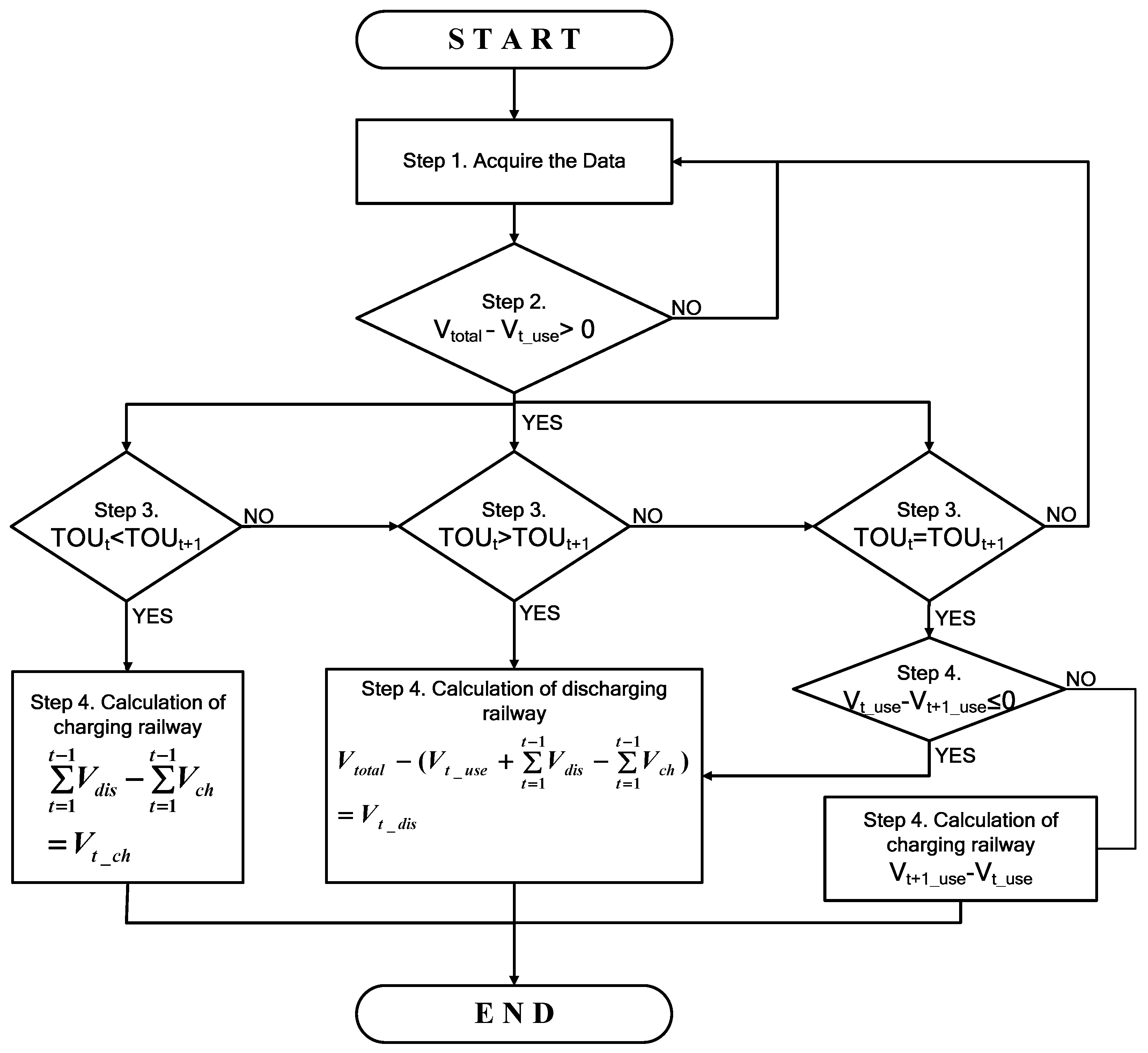
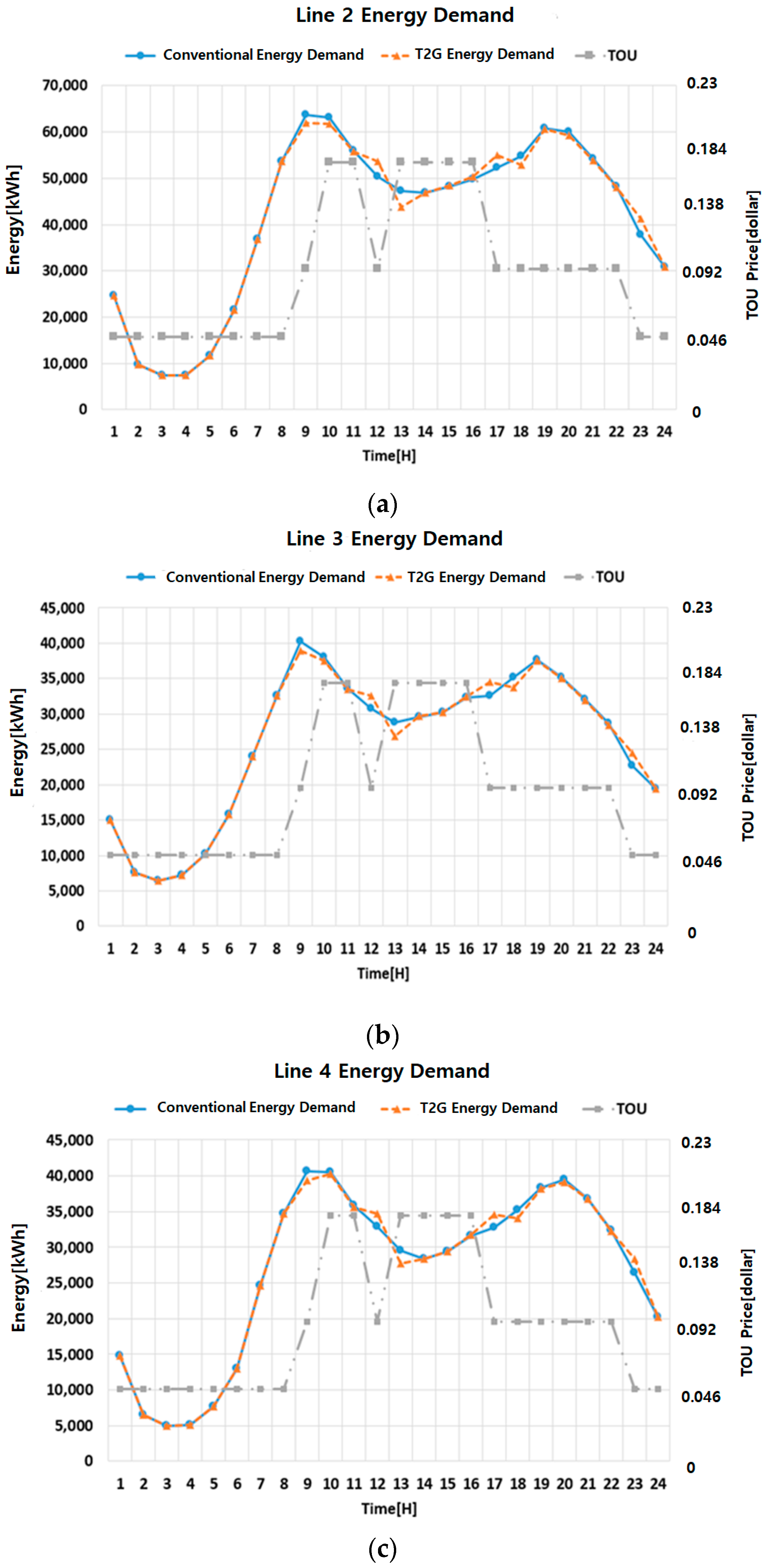
| Item | Line 2 | Line 3 | Line 4 | Note |
|---|---|---|---|---|
| Number of trains | 10 | 10 | 10 | - |
| Distance | 48.8 km | 38.2 km | 31.7 km | - |
| Energy consumption | 1220 kWh | 955 kWh | 793 kWh | Energy required for one-way |
| Item | Value |
|---|---|
| Maximum Energy Capacity | 109.65 kWh |
| Available Energy Capacity | 60.31 kWh |
| Voltage | 1555 V DC |
| Classification | Demand Charge ($/kWh) | Energy Charge ($/kWh) | ||||
|---|---|---|---|---|---|---|
| Time | Summer | Spring/Fall | Winter | |||
| High-Voltage A | Option II | 7.8 | Off-Peak | 0.053 | 0.053 | 0.059 |
| Mid-Peak | 0.102 | 0.074 | 0.102 | |||
| On-Peak | 0.179 | 0.102 | 0.156 | |||
| Classification | Summer (June, July, August) | Spring (March, April, May)/ Fall (September, October) | Winter (November, December, January, February) |
|---|---|---|---|
| Off-Peak | 23:00~09:00 | 23:00~09:00 | 23:00~09:00 |
| Mid-Peak | 09:00~10:00 | 09:00~10:00 | 09:00~10:00 |
| 12:00~13:00 | 12:00~13:00 | 12:00~17:00 | |
| 17:00~23:00 | 17:00~23:00 | 20:00~22:00 | |
| On-Peak | 10:00~12:00 13:00~17:00 | 10:00~12:00 13:00~17:00 | 10:00~12:00 17:00~20:00 22:00~23:00 |
| Time | Line 2 | Line 3 | Line 4 | Time | Line 2 | Line 3 | Line 4 |
|---|---|---|---|---|---|---|---|
| 1 | - | - | - | 13 | 32 | 16 | 17 |
| 2 | - | - | - | 14 | 32 | 17 | 17 |
| 3 | - | - | - | 15 | 33 | 16 | 16 |
| 4 | - | - | - | 16 | 41 | 17 | 17 |
| 5 | 25 | 5 | 4 | 17 | 52 | 24 | 20 |
| 6 | 44 | 20 | 17 | 18 | 55 | 27 | 27 |
| 7 | 60 | 27 | 26 | 19 | 50 | 25 | 25 |
| 8 | 63 | 33 | 32 | 20 | 39 | 23 | 20 |
| 9 | 57 | 29 | 25 | 21 | 33 | 21 | 19 |
| 10 | 36 | 21 | 20 | 22 | 30 | 18 | 15 |
| 11 | 33 | 18 | 16 | 23 | 24 | 13 | 13 |
| 12 | 32 | 16 | 16 | 24 | 12 | 10 | 6 |
| Time | Discharging | Charging | Time | Discharging | Charging | ||||||||
|---|---|---|---|---|---|---|---|---|---|---|---|---|---|
| 2 | 3 | 4 | 2 | 3 | 4 | 2 | 3 | 4 | 2 | 3 | 4 | ||
| 1 | - | - | - | - | - | - | 13 | 56 | 33 | 30 | - | - | - |
| 2 | - | - | - | - | - | - | 14 | - | - | - | - | 1 | - |
| 3 | - | - | - | - | - | - | 15 | - | 1 | 1 | 1 | - | - |
| 4 | - | - | - | - | - | - | 16 | - | - | - | 8 | 1 | 1 |
| 5 | - | - | - | - | - | - | 17 | - | - | - | 47 | 32 | 30 |
| 6 | - | - | - | - | - | - | 18 | 33 | 22 | 20 | - | - | - |
| 7 | - | - | - | - | - | - | 19 | 5 | 2 | 2 | - | - | - |
| 8 | - | - | - | - | - | - | 20 | 11 | 2 | 5 | - | - | - |
| 9 | 31 | 20 | 22 | - | - | - | 21 | 6 | 2 | 1 | - | - | - |
| 10 | 21 | 8 | 5 | - | - | - | 22 | 3 | 3 | 4 | - | - | - |
| 11 | 3 | 3 | 4 | - | - | - | 23 | - | - | - | 58 | 31 | 32 |
| 12 | - | - | - | 55 | 31 | 31 | 24 | - | - | - | - | - | - |
| Time | Conventional Energy Consumption (kWh) | Energy Consumption in Proposed Method (kWh) | ||||
|---|---|---|---|---|---|---|
| Line 2 | Line 3 | Line 4 | Line 2 | Line 3 | Line 4 | |
| 1 | 24,684 | 14,957 | 14,855 | 24,684 | 14,957 | 14,855 |
| 2 | 9706 | 7591 | 6488 | 9706 | 7591 | 6488 |
| 3 | 7413 | 6413 | 5023 | 7413 | 6413 | 5023 |
| 4 | 7401 | 7252 | 5080 | 7401 | 7252 | 5080 |
| 5 | 11,766 | 10,163 | 7687 | 11,766 | 10,163 | 7687 |
| 6 | 21,566 | 15,728 | 13,036 | 21,566 | 15,728 | 13,036 |
| 7 | 36,834 | 23,994 | 24,607 | 36,834 | 23,994 | 24,607 |
| 8 | 53,674 | 32,586 | 34,753 | 53,674 | 32,586 | 34,753 |
| 9 | 63,789 | 40,185 | 40,698 | 61,919 | 38,979 | 39,371 |
| 10 | 63,092 | 37,994 | 40,530 | 61,826 | 37,511 | 40,229 |
| 11 | 56,026 | 33,640 | 35,816 | 55,846 | 33,459 | 35,574 |
| 12 | 50,408 | 30,767 | 32,857 | 53,725 | 32,637 | 34,727 |
| 13 | 47,238 | 28,855 | 29,481 | 43,861 | 26,865 | 27,671 |
| 14 | 46,925 | 29,605 | 28,350 | 46,925 | 29,665 | 28,350 |
| 15 | 48,310 | 30,242 | 29,435 | 48,370 | 30,181 | 29,375 |
| 16 | 49,801 | 32,364 | 31,658 | 50,283 | 32,424 | 31,718 |
| 17 | 52,230 | 32,538 | 32,778 | 55,065 | 34,468 | 34,587 |
| 18 | 54,865 | 35,114 | 35,234 | 52,875 | 33,787 | 34,028 |
| 19 | 60,840 | 37,688 | 38,345 | 60,539 | 37,568 | 38,225 |
| 20 | 59,984 | 35,165 | 39,470 | 59,320 | 35,045 | 39,168 |
| 21 | 54,258 | 32,080 | 36,816 | 53,896 | 31,960 | 36,755 |
| 22 | 48,150 | 28,616 | 32,440 | 47,969 | 28,435 | 32,199 |
| 23 | 37,772 | 22,629 | 26,401 | 41,270 | 24,498 | 28,331 |
| 24 | 30,759 | 19,478 | 20,250 | 30,759 | 19,478 | 20,250 |
| Line | Case | Demand Charge ($) | Energy Charge ($) | Total Electricity Price ($) | Reduction Ratio |
|---|---|---|---|---|---|
| Line 2 | Base | 497,554 | 3,530,352 | 4,027,906 | - |
| Proposed method | 482,968 | 3,514,762 | 3,997,730 | 30,176 ($) (0.75% ↓) | |
| Line 3 | Base | 313,349 | 2,193,828 | 2,507,177 | - |
| Proposed method | 303,944 | 2,184,769 | 2,488,713 | 18,464 ($) (0.74% ↓) | |
| Line 4 | Base | 317,346 | 2,256,044 | 2,573,390 | - |
| Proposed method | 307,001 | 2,247,467 | 2,554,468 | 18,922 ($) (0.74% ↓) |
© 2018 by the authors. Licensee MDPI, Basel, Switzerland. This article is an open access article distributed under the terms and conditions of the Creative Commons Attribution (CC BY) license (http://creativecommons.org/licenses/by/4.0/).
Share and Cite
Go, H.-S.; Cho, I.-H.; Kim, G.-D.; Kim, C.-H. Reduction of Electricity Prices Using the Train to Grid (T2G) System in Urban Railway. Energies 2018, 11, 501. https://doi.org/10.3390/en11030501
Go H-S, Cho I-H, Kim G-D, Kim C-H. Reduction of Electricity Prices Using the Train to Grid (T2G) System in Urban Railway. Energies. 2018; 11(3):501. https://doi.org/10.3390/en11030501
Chicago/Turabian StyleGo, Hyo-Sang, In-Ho Cho, Gil-Dong Kim, and Chul-Hwan Kim. 2018. "Reduction of Electricity Prices Using the Train to Grid (T2G) System in Urban Railway" Energies 11, no. 3: 501. https://doi.org/10.3390/en11030501




